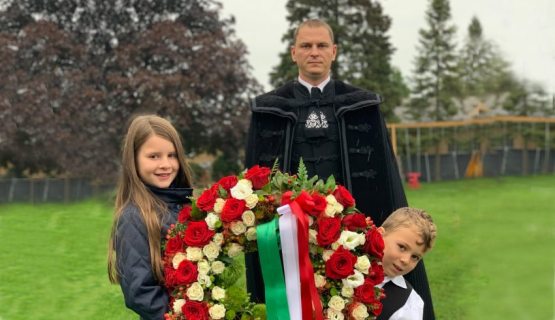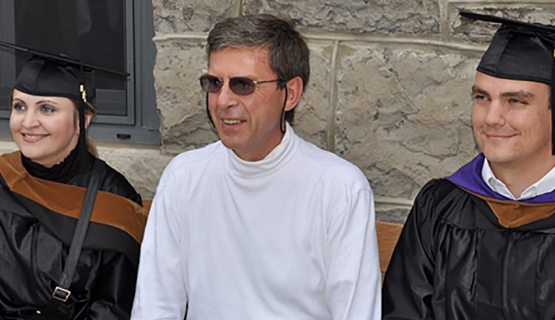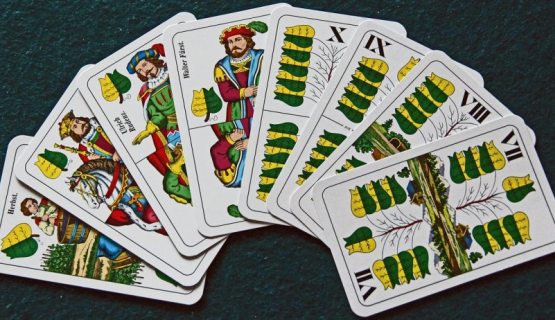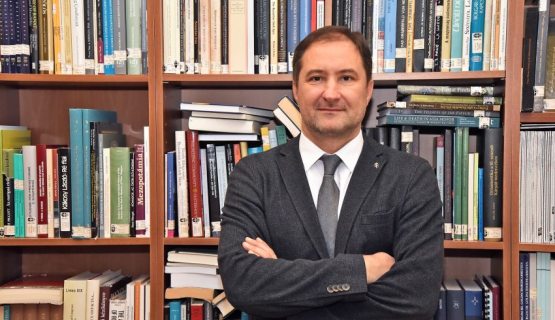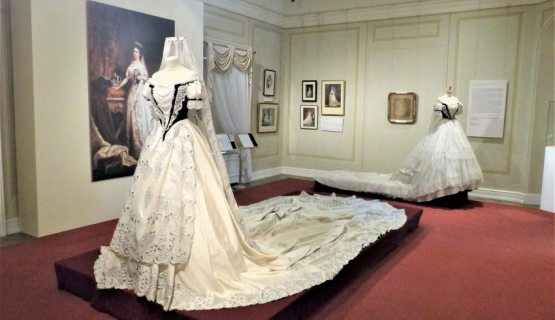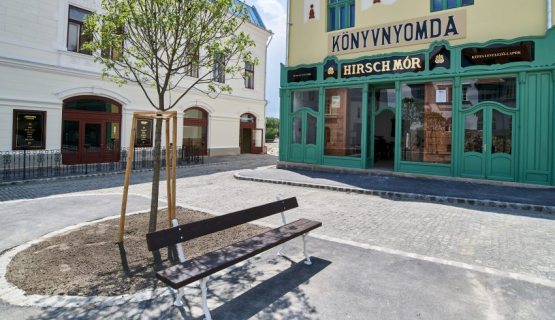"It’s a bit of a miracle that these communities have kept the language, the culture" – the advent trip of young people of Hungarian origin from South America
Camila's parents are Hungarian, but she grew up in Argentina. David's mother is Hungarian and his father is Colombian, and while they live not far from Bogota, his grandparents live in Csorna, western Hungary. Kati Zágon, 65, was born in Brazil after her parents from Tata and Zemplén emigrated after World War II. What they have in common is that they all came to Hungary with the Diaspora Programme of the Rákóczi Association to spend ten days on an Advent trip to learn about their ancestors' culture. We visited the participants of the program in Budapest.

Fourth and fifth-generation descendants
On a weekday morning, the Benczúr Hotel in the City Park is a hive of activity, trying to get forty children in one room. We are at the Advent camp of the Diaspora Programme of the Rákóczi Association, where forty teenagers of Hungarian origin, mainly from South America, will spend 10 days between 11 and 20 December. The study trip gives them the opportunity to learn about the places their ancestors come from. The young people come from Brazil, Argentina, Colombia, Australia and Northern Macedonia.
Liza Paulik is participating for the second time after a summer camp in 2019. She is one of the participants whose parents and grandparents are all Hungarian. Her parents moved to Australia four years ago for work, and her grandparents and cousins all live here. She tells me that there is a strong Hungarian community in Australia, and they try to keep the Hungarian traditions. "There is a Hungarian school, a Hungarian church, we go there with the family." Liza, 18, has already graduated from high school but has no plans to return to Hungary yet, as she will start university in March. When I ask her what the biggest experience of the camp has been so far, she names the boat trip.
Born in Rio de Janeiro, but living in São Paulo, 65-year-old Kati Zágon, who serves as a chaperon, and has long been active in the Brazilian Hungarian community translates to Portuguese for the children.
Many Hungarians emigrated to Brazil around 1932-33, and later in 1949 and '56. These are the largest Hungarian colonies in the South American country. "My mother is from Zemplén, my father is from Tata.
My parents left in 1949, after the Second World War, both Hungarians, but they met in Brazil. I have relatives here in Hungary on both my mother's and father's sides.
My father had six siblings, unfortunately, my parents are no longer alive, but my son moved here a few years ago, so I often come to visit," she says.
Kati has been teaching Hungarian for ten years, and she told me that the children in the programme, who come from Brazil, speak no or only a few words of Hungarian. "They are fourth- or fifth-generation descendants, so Hungarian is difficult for them. Families try to keep the Hungarian customs, but there are many mixed marriages, sometimes neither parent speaks Hungarian, so they don't speak Hungarian at home anymore. They know a couple of words, for example, "szia". We teach them very playfully," she explains. The Hungarian schools and scouting are where they meet Hungarian words.
"I really enjoy that on these field trips I always learn something new and see something new. They're kids and they have a different mindset than we do, but they feel they belong to this community, they have their roots here," she says.
"We do Easter sprinkling at home"
My next interviewee is Camila Blahó from Argentina, who will write her name down when I ask her to. Although she has a strong accent, she seems to understand the language well. Her family history is hardly a straight line – which is not rare among the participants. She says her parents are both Hungarian, born in Argentina, but she was born here and returned to Argentina when she was eight months old.
"We speak Hungarian at home. We go to Hungarian scouts, we do Easter sprinkling, we paint eggs, we learn folk songs, folk dancing," she says.
Camila goes to a so-called Saturday Hungarian school, where she also takes exams in Hungarian History, Literature and Geography.
”Finding friends!” – she says when I ask her what she likes about this trip. Then she has to rush, as it's after 9am and today's programme starts.
The kids will first meet Csongor Csáky, President of the Rákóczi Association. After a short introduction, a film screening will follow, during which Kati, the chaperon, will translate into Portuguese, while Lívia Buhajla, the communication officer of the Rákóczi Association, will translate into English.
They are on a tight schedule, with a morning walk in the City Park, lunch and then a 300-kilometre journey ahead. After their experiences in Budapest, they will spend a few days in Sátoraljaújhely, in the Rákóczi camp, touring the nearby villages and getting a taste of the Advent preparations in the countryside. Tokaj, Cigánd and Sárospatak will also be among the places they visit. While the children and their chaperones gather and collect their suitcases, we sit down for a chat with Csongor Csáky and discuss the past and present of the Diaspora Programme.
A kid from Moldavia and one from Buenos Aires chat in Hungarian
"School holidays are at a different time in each country, in the southern hemisphere it's summer now, so many people from Argentina, Brazil and Australia could only come now. They come from summer to winter at this time of the year. They are immersed in a Christmas in winter, because they celebrate Advent and Christmas in the summer at home," he begins.
The Rákóczi Association launched the Diaspora Programme in 2016 with the support of the government. Although the trips had to be stopped for two years due to the coronavirus epidemic, they were restarted at the end of January this year.
This year, 443 young people from around thirty countries - including South Africa, Colombia, New Zealand, Canada, Argentina and Israel - have already participated in the programmes such as a pilgrimage to Csíksomlyó or summer camps.
Most of the campers were high schoolers and college students.
"In the summer camps, 500 young people were together for a week, and it was a great experience to see how a kid from Moldavia talked to a kid from Buenos Aires in Hungarian", recalls the President of the Rákóczi Association. He stresses that these young people come here because one of their parents or grandparents is of Hungarian origin, which plays a decisive role in their idenInterestinglyw can they keep and live their Hungarian identity more than 10,000 kilometres from us? - I asked. "Interestingly enough, in South America, it is through Hungarian folk dance. In many cases, young people from Uruguay, Argentina, and Brazil come here without knowing a word of Hungarian but dancing Hungarian folk dances which gives them a strong sense of Hungarian identity. They can dance, but they can't speak Hungarian, and they come and immerse themselves a little in Hungarian culture. It's interesting that those who come from the US or Australia cultivate the language more, while the those from Israel speak the language less, but they are more attached to Hungary," he explains.
At the beginning of the 20th century, even before the First World War, Hungarians emigrated to the New World, i.e. to the American continent, and then during and after the First and Second World Wars, and again in 1956. "Everyone has their own story of how they got where they are. It's a bit of a miracle that these communities have kept their language and culture," says Csongor Csáky.
They return to university
Most of the children who come here go to Sunday school and belong to Hungarian scout groups and folk dance groups. To be able to participate in the trip, they had to ask for a recommendation from the Hungarian Diaspora Council that they are an active member of the local community.
"It is also an inspiration for them to return home and become more active there. Many fall in love with Hungary. It's very common that they come to Hungary as high schoolers, fall in love with the country, marvel at how beautiful it is, and come back later," explains Csáky Csongor.
Therefore, the Ministry of Foreign Affairs has a special scholarship programme, the Hungarian Diaspora Scholarship, which is aimed at young Hungarians from the diaspora, with 70-80 young people applying every year.
From 36 degrees Celsius to winter
As soon as we finish talking, the organisers tell us it’s time to leave for Heroes' Square. It's well below zero outside, but everyone seems to have gotten used to the Hungarian winter in the last few days. This week they've been to the castle, the Parliament and even on a boat trip on the Danube.
The participants came to Hungary in separate groups from each country, led by their chaperones. The only exception is 14-year-old David, the only student from Colombia. As we walk, he tells me his own family story in English, sometimes in Hungarian. Born in Spain, his father is Colombian, and his mother is Hungarian, he was six when they moved to Colombia and they now live not far from the capital Bogota. However, David's grandparents still live in Csorna, in the county of Győr-Moson-Sopron, in western Hungary. The 14-year-old boy has been in Hungary with his mother since November, as not only do his grandparents live here, but also one of his brothers is studying here.
How good is your Hungarian? - I ask. "I understand what they say, but it's a bit difficult to write or speak," he replies in Hungarian, and we switch back to English. When I ask him what he likes most about Budapest, he mentions the Christmas decorations. "I've never seen anything like it anywhere else, it's beautiful," he adds.
After a few hundred metres of walking, the staff of the Rákóczi Association will give a short guided tour of Heroes' Square. The students learn about the Millennium Monument, the seven leaders, and that the subway they have been travelling on started in 1896 and is Europe's first metro line.
"Small in front, big behind", the organisers ask.
The group photo is being shot, and everyone shouts "Rákócziii" instead of "Cheese".
And of course, the inevitable selfies are taken. Meanwhile, the children from Argentina are looking remarkably happy despite the sub-zero temperatures, as if they were dancing. "For someone who came from 36 degrees Celsius, they're coping quite well with the cold," says one of the organisers. They are particularly happy because Argentina beat Croatia on Tuesday to reach the World Cup final. It was a great night of cheering, watching the game, and celebrating,- they say. Well, let’s see how they can celebrate if they win the World Cup...
The Advent camp ends on 20 December and everyone can spend Christmas at home. But for most of them, this was certainly not their last visit to Hungary.



